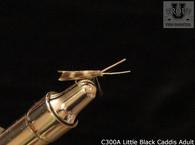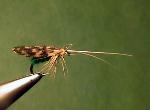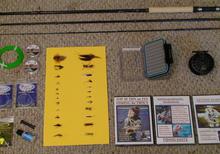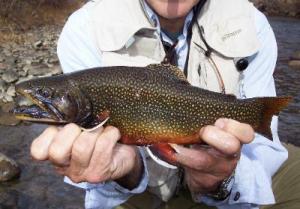
Learn about the numerous species such as rainbow trout, brown trout, brook trout, Dolly Varden trout, hybrid trout and more. For example, did you know that in the Appalachian Mountains they refer to brook trout as speckled trout?
When I decided to start fishing for trout, I did not even know what they looked like, or how to distinguish them from any other fish. After, I started to catch a few trout, I was not sure what species it was, so I would guess. If someone would ask "Did you see any trout". I would respond, "I saw some trout and I think that they were Rainbow Trout". To avoid that confusion, we are describing the various species in this section.
Though there are a number of trout species in the US, the three most common species (and the ones that receive the most attention) are brook, rainbow, and brown trout.
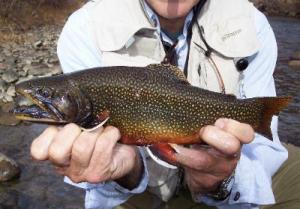
Brook Trout (Salvelinus fontinalis). The brook trout, or speckled trout as it is called locally, is the only trout native to North Carolina. This member of the char family is found only in coldwater streams of the mountains. Often a brilliantly colored fish, it is readily identifiable by the white leading edge, backed by black, on its lower fins. Today they are scarce except in relatively remote headwater streams. Rainbow and brown trout are not stocked into streams which contain only wild brook trout. The brook trout is easy to catch and their numbers can be reduced by fishing, or eliminated by accompanying habitat changes. The typical brook trout caught today is eight inches or less in length. A 12-inch or longer fish is a rarity.
Rainbow Trout (Oncorhychus mykiss). Rainbow trout, native to the western slopes of the Sierra Nevada range in the western United States, were introduced into North Carolina as early as the 1880s. Since then they have been stocked in most trout waters in the state, and have become the backbone of our trout fishery. Rainbows are distinguished by the presence of a pinkish to red longitudinal band, varying numbers of black spots, and a frequently pink or red gill cover. Fish up to 12-inches long are common, and occasionally larger specimens are taken. Rainbow trout do best in clear, cool, cascading type streams, but can survive in waters too warm or too silt-laden for brook trout. In streams where both rainbow and brook trout occur, rainbow usually dominate. Rainbow trout are known as spectacular fighters, and frequently jump from the water when hooked.
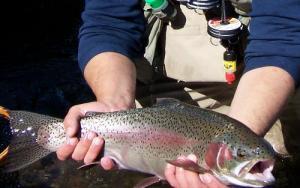
Steelhead Trout This anadramous (ocean-going) version of a rainbow trout is born in freshwater streams and rivers in the mountains along the West coast of the US, grows to adulthood in the Pacific Ocean, and returns to freshwater to spawn. Because of the time they spend in the ocean, they typically reach much larger sizes than their landlocked cousins, though they are less colorful.
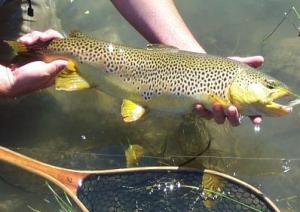
Brown Trout (Salmo trutta). Brown trout, native to northern Europe, were imported into this country from Germany and Scotland in the late 1800s. Brown trout can be distinguished by their brownish-yellow color and the scattered black, red, and orange spots on their sides. The typical brown trout taken from North Carolina water is 12 inches or less in length, but fish greater than 18-inches long are occasionally taken. Brown trout are extremely wary and are the most difficult of the trout to catch. Frequently, inexperienced anglers fishing in brown trout water will not get so much as a strike, and are convinced that there are no fish in the stream. In actuality, there may be an excellent population of wild browns. Brown trout prefer larger, slower flowing streams with large stones or fallen trees to provide cover. However, they also do well in some of the smaller, swifter streams too. Brown trout are stubborn fighters when hooked, but do not put on as spectacular an acrobatic show as the rainbow. Instead, they tend to go to the bottom and run underneath a log or into a rock crevice.
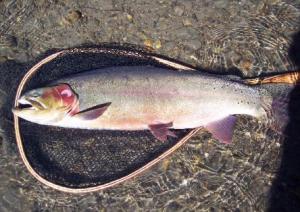
Cutthroat Trout (Oncorhynchus clarki). Cutthroat trout are indigenous to the Rocky Mountains. They get their name from the distinctive red coloration around their throat, and they were first described to the scientific community by the Lewis & Clark expedition. See the link below for further information.
Golden Trout (Oncorhynchus mykiss aguabonita). Golden trout are found in the upper elevations of the Sierra Nevada Mountains. They are a subspecies of Rainbow Trout. See the link below for further information.
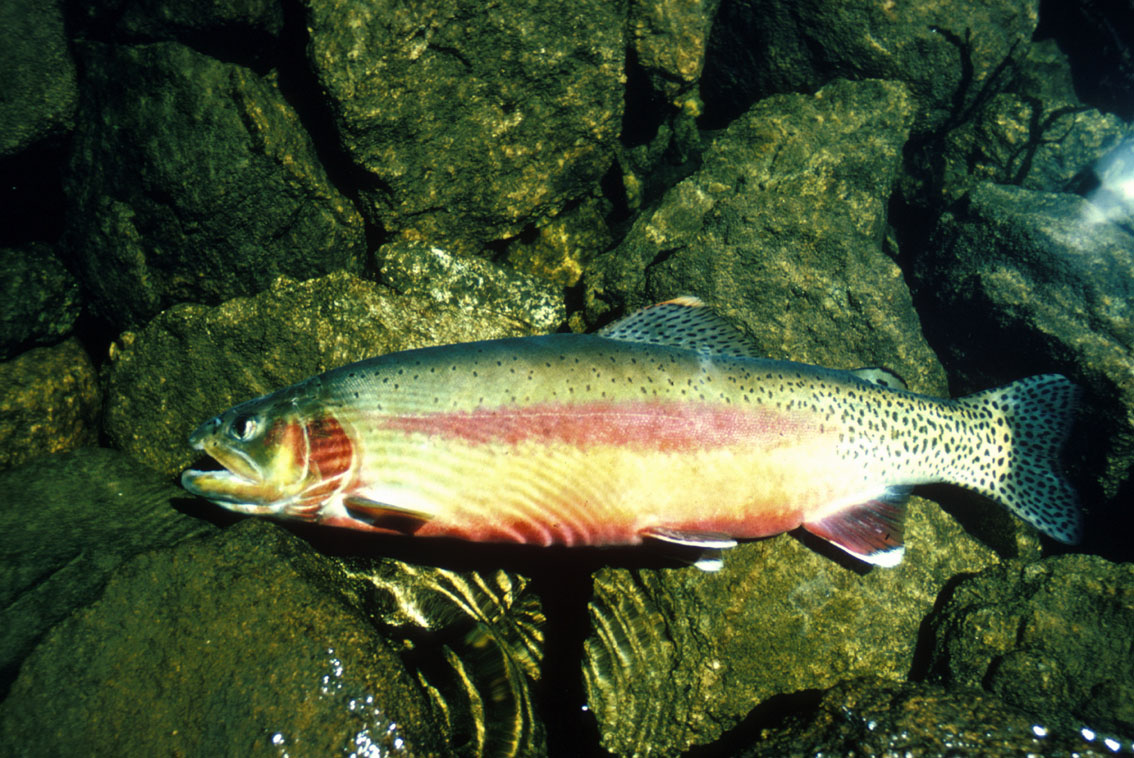
Palomino Rainbow Trout Golden rainbow trout and palomino rainbow trout are not sterile hybrids, they are simply color variations of rainbow trout (Oncorhynchus mykiss) and should not be confused with the golden trout (Oncorhynchus aguabonita) native to a few drainages in California. It took selective breeding for several generations to result in the development of true breeding golden rainbow trout. Typically, these fish are more of a brilliant golden color than the palomino rainbow trout, which has a color phase intermediate between the golden and normally pigmented rainbow trout.The golden rainbow trout originated from a single rainbow trout that was spawned in the fall of 1954 in West Virginia. This trout's body color was a chimera of golden and normally pigmented tissue. When this fish was crossed with a normally pigmented rainbow trout, the offspring (what we have come to refer to as palomino rainbow trout) were lighter in color.
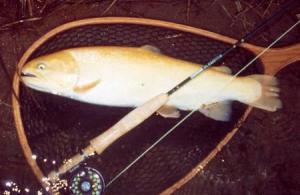
Donaldson Trout The Donaldson trout was developed by the University of Washington thru selective breeding and nutrition, to attain a large body size in a short amount of time. Trout usually reach sexual maturity in about 4 years and weigh 1 1/2 pounds. The Donaldson, however, mature is two years and weigh up to 10 pounds, and they are prolific producing more eggs.
Bull Trout (Salvelinus confluentus). Bull trout are in the char family. They are usually found in the higher elevations of the Western US mountains, from Alaska to Nevada. See the link below for further information.
Lake Trout (Salvelinus namaycush). Lake trout, found primarily in lakes in the northern parts of North America, are members of the char family. They are typically found deep in lakes, and they are often caught by trolling. See the link below for further information.
Dolly Varden (Salvelinus malma malma). Dolly Varden, named for a character in a Charles Dickens' book known for wearing colorful clothes, are also members of the char family. They are typically found in the northwest US (Alaska) and even Russia. See the link below for further information.
Tiger Trout (Salmo trutta X Salvelinus fontinalis). Tiger trout are a cross between a brown trout and a brook trout. These are extremely rare in nature. See the link below for further information.
Triploid Trout: Triploid rainbow trout are named triploid because they possess three sets of chromosomes which render them sterile. The triploidy process involves the heating of eggs at 26 to 27 degrees C for 20 minutes at 20 minutes after fertilization
Other Trout Species Below are some additional links to some more obscure trout species.



